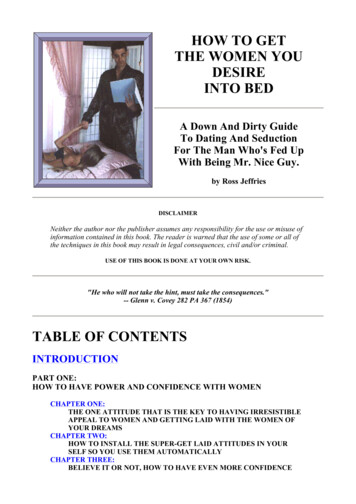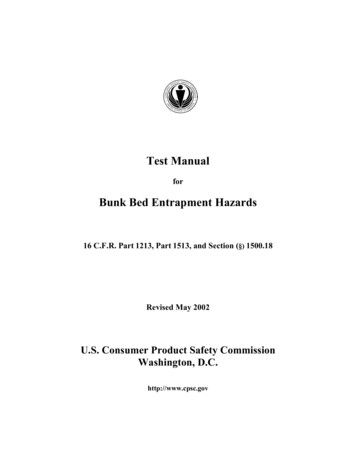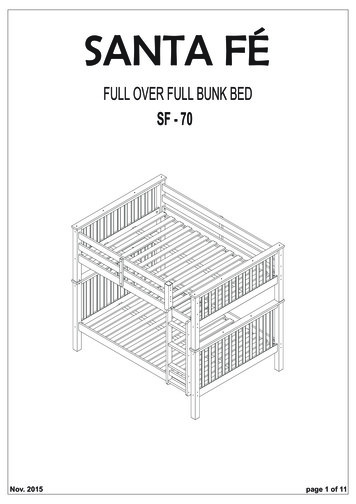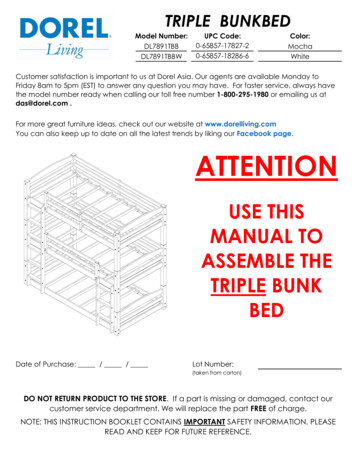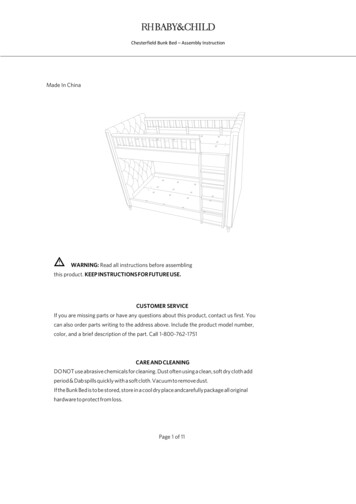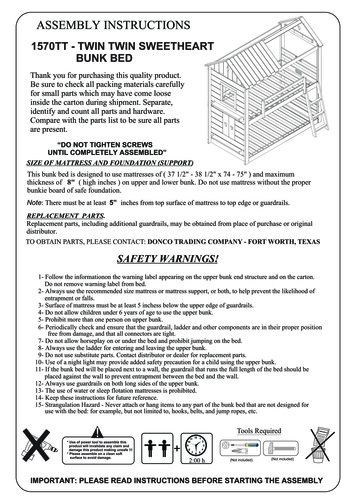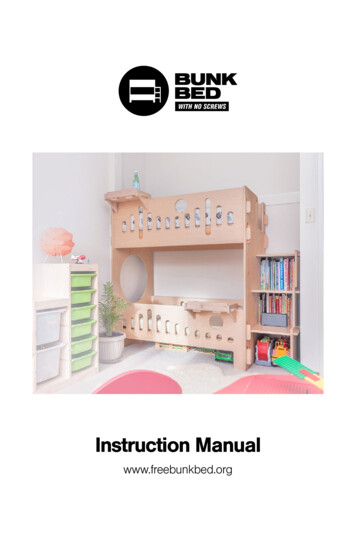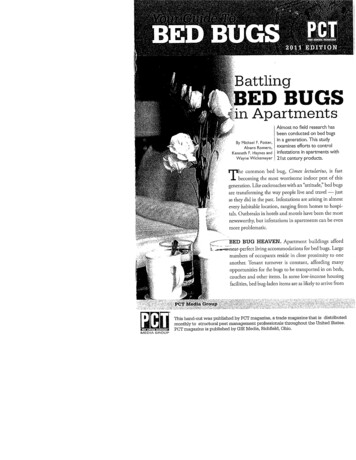
Transcription
MT cairn.Iiiii;lotooir2011 EDITIONBattlingBED BUGS*in ApartmentsAlmost no field research hasbeen conducted on bed bugsBy Michael F. Potter,Alvaro Romero,Kenneth F. Haynes andWayne Wickemeyerin a generation. This studyexamines efforts to controlinfestations in apartments with21st century products.he common bed bug, Cimex lectularius, is fastbecoming the most worrisome indoor pest of thisgeneration. Like cockroaches with an "attitude," bed bugsare transforming the way people live and travel — justas they did in the past. Infestations are arising in almostevery habitable location, ranging from homes to hospitals. Outbreaks in hotels and motels have been the mostnewsworthy, but infestations in apartments can be evenmore problematic.TBED BUG HEAVEN. Apartment buildings afford.qqr.,near-perfect living accommodations for bed bugs. Largenumbers of occupants reside in close proximity to oneanother. Tenant turnover is constant, affording manyopportunities for the bugs to be transported in on beds,couches and other items. In some low-income housingfacilities, bed bug-laden items are as likely to arrive fromPCT Media GroupThis hand-out was published by PCT magazine, a trade magazine that is distributedmonthly to structural pest management professionals throughout the United States.PCT magazine is published by GIE Media, Richfield, Ohio.MEDIA GROUP
BHD E3G-FACTS Adult bed bugs are about I/8-inch longwith reddish-brown, oval flattened bodies.The nymphs resemble the adults but are--.„.gwittc,-.Z1Clutter is a major impediment to controlling bed bugs inapartments.smaller and somewhat lighter in color. Bed bugs feed solely on the blood ofspeck. When first laid, the eggs are sticky,animals. The common bed bug, C. lectu-causing them to adhere to substrates.larius, prefers feeding on humans, but willalso bite other warmblooded animals,including pets. Newly hatched nymphs are no biggerthan apinhead. As theygrow,they shed their skin fivetimes before reaching maturity. A blood meal They feed by piercing the skin with anis needed between each sucessive molt.elongated beak. The person seldom knowsthey are being bitten. Bite symptoms vary Under favorable conditions (70 Fto 90 F),from an itchy welt or localized swelling tothe bugs can complete development in aslittle as a month, producing three or morelittle or no reaction.generations per year. Although they can harbor pathogensin their bodies, disease transmission by Nymphs can survive months withoutbed bugs to humans is considered highlyfeeding and the adults for more than a year.Infestations are therefore unlikelyto diminishunlikely.by leaving premises unoccupied. Bed bugs do not fly but can move rapidlyoverfloors, walls, ceilings and other surfaces. Bed bugs are active mainly at night. Dur-If necessary, they will crawl more than 100ing the daytime they prefer to hide close tofeet to obtain a blood meal.where people sleep. Female bed bugs lay their eggs in secluded Bed bugs do not have nests like antsareas, depositing up to five a day and up toor bees but do tend to congregate in ha-500 during a lifetime.bitual hiding places. Typicallythese areas are The eggs are whitish and hard to seesometimes are accompanied by a sweetishon most surfaces without magnification.odor. Also presentwill be eggs and eggshells,Individual eggs are about the size of a dustand molted skins of maturing nymphs.marked by dark spotting and staining, andBed Bug Fact Sheet
Your Guide To BED BUGSthe curb or Dumpster as from the movingvan. Visits by guests help to spread infestations, as does communal use of laundryfacilities. Poor resident cooperation alsocan be a problem, and we have seen seriousmisuses of pesticides by tenants attemptingto control infestations themselves. From thebed bug's perspective, though, the greatestsurvival advantage of apartments may beclutter. Much as with cockroaches, clutterand close living quarters provide endlessplaces for the bugs to hide, thrive, and avoidextermination.FIELD TRIAL. Bed bug managementtactics include such measures as laundering,vacuuming, heating, bed encasement, anddisposal of infested items. Treatment withinsecticides, however, is by far the mainapproach used by pest control companies.Despite this, very little has been reportedon the outcome of modern-day insecticidetreatments for bed bugs in challengingA small number of liquidinsecticides have moredetailed and permissibledirections, includingtreatment of mattresses,upholstered furniture andsurfaces where peoplemay be laying or sitting.environments such as apartments.To remedy this lack of knowledge, in2005, we initiated such a trial using insecticides commonly applied by pest managers.Thirteen bed bug-infested apartment unitsin Cincinnati, Ohio, were identified by alocal firm specializing in bed bug control inthis market (Permakil Pest Control, based inCovington, Ky.). Four of the 13 units werelocated within the same apartment building,Sofas are a common info tion site for bed bugs.Bed Bug Fact Sheet
A large aggregation of bed bugs fo d behind a headboard,two were from another building, and theremaining seven were located in separatebuildings around the city.Most of the apartments were rented bytenants in the low- to mid-income range.Each unit was thoroughly inspected beforeinitial treatment, recording numbers of livebed bugs (adults and nymphs) residing onbeds, furniture, floors, walls, ceilings andother locations. Pretreatment infestationlevels varied widely from a low of eight livebed bugs found in one apartment unit toalmost 3,000 in another. Adjoining unitswere also inspected and treated if necessaryin a manner similar to the test units.Prior to treatment, residents were askedto remove, bag and launder bed linens andclothing. Some tenants complied with thisrequest while others did not. Tenants werenot asked to disassemble beds or dispose ofbed bug-infested mattresses, box springs,couches or other belongings. While throwingout infested items is sometimes advisable,it can be financially impractical for manyresidents, including many of those involvedin this study. Retaining infested beds,couches, etc. further allowed us to determineif they could be successfully treated withappropriately labeled insecticides. No bedencasements were installed on mattressesor box springs while insecticide treatmentswere being evaluated.All 13 apartments were treated withSuspend SC (0,06 percent deltamethrin)as the primary liquid insecticide. Applications were thorough, targeting areas wherebed bugs were found or likely to crawl orhide. This included seams, tufts and crevicesof mattresses, box springs, bed frames andheadboards; along and beneath baseboards;seams, tufts, and crevices of upholsteredchairs, sofas and wood furniture; floor areasunder beds and couches; ceiling-wall junctures; and behind wall mounts such as mirrors and picture frames. The average amountof Suspend SC applied per apartment on theinitial service was 0.9 gallon (between .25gallon and 1.5 gallon), whereas follow-up applications typically used between .25 gallonand .5 gallon. Other bed bug-infested/proneareas were treated with Drione (silica gelplus pyrethrins) or DeltaDust6(0.05 percentBed Bug Pact Sheet
deltamethrin). Principal application sitesfor these dust formulations included underbaseboards and carpet edges, behind outletsand switch plates, and the inner frameworkof couches and box springs. Additionalproducts used in small amounts in someapartments included CB-80 Extra"' (0.5percent pyrethrum), Steri-Fab (primarilyalcohol plus d-phenothrin), and Invader.HPX (1 percent propoxur).Four to six (bi-weekly) follow up inspections were made of each apartment, performing additional treatments as needed.The number of live bed bugs found inspecific areas (mattress, box spring, couch,baseboard, etc.) was recorded on each servicevisit. (All inspections, counts and treatmentswere performed by the authors, primarilyW. Wickemeyer.)BH:D B -SGFACTSAll 13 apartments were treatedwith Suspend SC (0.06 percentdeltamethrin) as the primaryliquid insecticide. Applicationswere thorough, targeting areaswhere bed bugs were found orlikely to crawl or hide. This included seams, tufts and crevicesof mattresses, box springs, bedframes and headboards; alongand beneath baseboards; seams,tufts, and crevices of upholsteredchairs, sofas and wood furniture; floor areas under beds andcouches; ceiling-wall junctures;and behind wall mounts suchas mirrors and picture frames.The average amount of SuspendSC applied per apartment onthe initial service was 0.9 gallon(between .25 gallon and 1.5 gallon), whereas follow-up applications typically used between .25gallon and .5 gallon. Other bedbug-infested/prone areas weretreated with Drione (silica gelplus pyrethrins) or DeltaDust (0.05 percent deltamethrin).Principal application sites forthese dust formulations includedunder baseboards and carpetedges, behind outlets and switchplates, and the inner frameworkof couches and box springs.An adult bed bug feeding on a family dog.Bed Bug Fact Sheet
Your Guide To BED BUGSFigure 1: Bars represent the mean number ofbed bugs per apartment before initial treatmentand at bi-weekly intervals thereafter.500BED BUGCOUNTS4008, 300-a0a)"?200z100-0Initial W02 W04 W06W08W10 W12Week NumberSource: University of KentuckyTREATMENT OUTCOME. Succesinspections and treatments produceda steady decline in bed bug numbers (seeFigure 1 above). In 10 of the 13 apartments,live bed bugs could no longer be found aftertwo to five treatments (mean 3.0). Threeapartments, however, continued to havesivelow-level infestations at the terminationof the study due in part to poor tenant/management cooperation. Two of thesetenants were suspected of reintroducinginfested items while another cancelled serviceprematurely. Compared to the total initialnumber of bed bugs found in the 13 apartments, a 94 percent overall reduction wasobserved after two treatments, 95 percentfewer bugs were found after four treatments,and 88 percent fewer after six treatments.Excluding one unit where tenants weresuspected of reintroducing infested itemsmid-way through the study, the decline inbed bug numbers after two, four, and sixtreatments, respectively, was 94 percent, 97percent and 99 percent.Figure 2, at right, summarizes the distribution of bed bugs found within all apartments. As expected, the greatest amount(70 percent), were associated with beds, ofwhich 35 percent was on box springs, 22percent was on mattresses, and 13 percentwas on bed frames and headboards. Sofasand reclining chairs harbored the nextlargest number (23 percent), reflecting thetendency of bed bugs to reside near a sleeping host. Couches and recliners were so bedbug-prone, in fact, that in eight out of 13apartments they were the main location ofinfestation. The remaining 7 percent of thebugs were associated with walls, ceilings andbaseboards; nightstands and dressers; molding and shelving, etc. Small numbers of bedbugs were also found in less obvious places,Bed Bug Fact Sheet
Figure 2: Distribution of bed bugs found in 13 infested apartments.2,3%BED BUGHIDING SPOTS3 . 1%Ei Mattress.2%BoxspringFrame/HeadboardBaseboard AreasCouch/Chair1 . 4%34.6%11 Nightstand/DresserWalls/CeilingOtherSource; University of Kentuckyincluding inside books, a coffee maker, andunder a deodorant dispenser. Some of theseharborage sites were several feet from sleeping areas, underscoring the importance ofinspecting well beyond beds.LESSONS LEARNED. It was encouraging to see that bed bug infestations could bereduced to non-detectable levels under thechallenging conditions of this study. Fewinfested items were discarded, and otherpotentially useful tactics such as bed encasement, vacuum cleaning and steam treatmentwere not incorporated in the study.The single most important and oft-statedlesson from this study is that bed bugs arehard to eradicate. To achieve the reportedoutcome, thorough inspections and repeated applications were made using quite alot of insecticide. The amount of time spentin each apartment on the initial serviceranged from one to two man-hours, witheach follow-up service listing at least anadditional hour (sometimes much more).Actual time spent depended on the severityof infestation and amount of clutter andtenant cooperation. Some clients, like theone who cancelled service prematurely, willbe unwilling to pay for such labor-intensiveservice. In these cases, the bed bug problemis almost certain to continue.Even with a large investment ofeffort, thereare no guarantees that all the bed bugs havebeen eliminated. No inspection, howeverthorough, can uncover every potential hidingplace for bed bugs in a building. Young bedbug nymphs are tiny and the eggs are barelynoticeable except under magnification. Following treatment, weeks or months maypass with no reports of people being bitten.Eventually though, the problem may resurface either from reintroduction of infesteditems, migration of bed bugs from otherliving units or survival of the pre-existingpopulation. It is noteworthy that three out ofthe 13 apartments in our study (23 percent)continued to have small numbers of bedbugs when the trial was finally terminatedthree months after initial service. Othercompetent, hardworking pest managementfirms have battled bed bugs in accounts formuch longer than this, indicating there isBed Bug Fact Sheet
Bed bugs have oval, flattened bodies.no "standard" or "guaranteed" timeframe inwhich infestations can be eliminated.Why it often takes a long time to controlbed bugs is unclear. Finding hidden aggregations in cluttered apartments is obviouslyone big hurdle, but susceptibility to today'sinsecticides may also be a factor. On morethan one occasion, bed bugs were foundliving on surfaces we had previously treatedwith residual insecticides. While it's possiblethese insects had not yet had sufficient timeto acquire a lethal dose, another possibilityis that they simply were not being affected.Further testing is underway to study thisphenomenon, and susceptibility of fieldpopulations to various insecticides andmethods of exposure,More than 90 percent of the bed bugs inour study were found on bed components,couches and recliners. Ironically, these are thesame places that most of today's insecticidesare not to be used. Bed bugs are not listedas a target pest on many product labels, andeven when they are, use directions are oftenvague (e.g., "apply into cracks and creviceswhere pests are found or normally occur").A small number of liquid insecticides suchas Suspend SC, Steri-Fab and Bedlam havemore detailed and permissible directions,including treatment of mattresses, upholstered furniture and surfaces where peoplemay be laying or sitting.Considering the current legal and regulatory climate, it's questionable how manyproducts will have such liberal label directions in the future unless perhaps bed bugsbecome as common as in the past, which wethink is quite likely. (Food for thought: inEurope in the 1930s, 47 percent of movingvans inspected were found to be infestedwith bed bugs).With time, the industry will become moreskilled at managing bed bug infestations,although society's intolerance of the pest andpesticides will pose many challenges. Muchcan be learned about the challenges we facefrom the past. If history repeats itself, we arein for quite a ride.All photos are courtesy ofME PotterMichael E Potter and Kenneth F Haynes are professorsat the University ofKentuefky. Alvaro Romero is a Ph.D.student at the same institution. Wayne Wickemeyeris a 26-year industry veteran and senior pest controltechnician with Permakil Pest Control, Covington,Ky. Funding for the study was provided by BayerEnvironmental Science.Bed Bug Fact Sheet
this market (Permakil Pest Control, based in Covington, Ky.). Four of the 13 units were located within the same apartment building, Sofas are a common info tion site for bed bugs. Bed Bug Fact Sheet. A large aggregation of bed bugs fo d be


